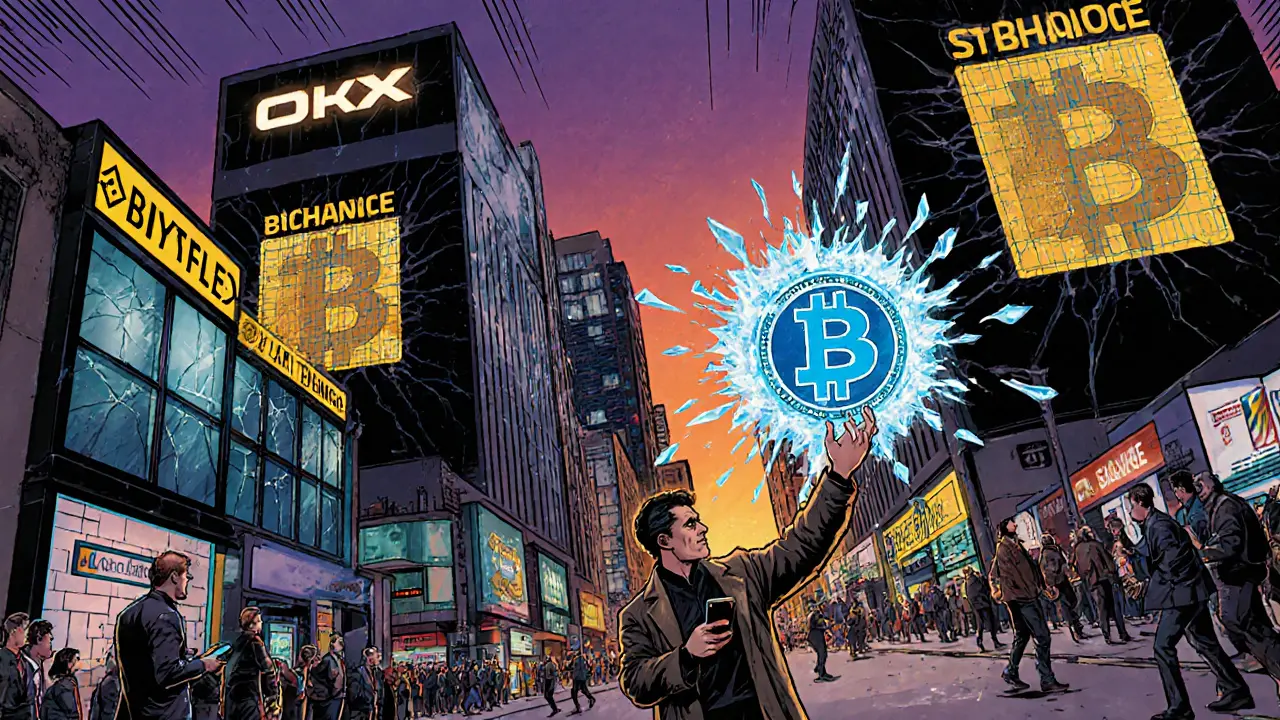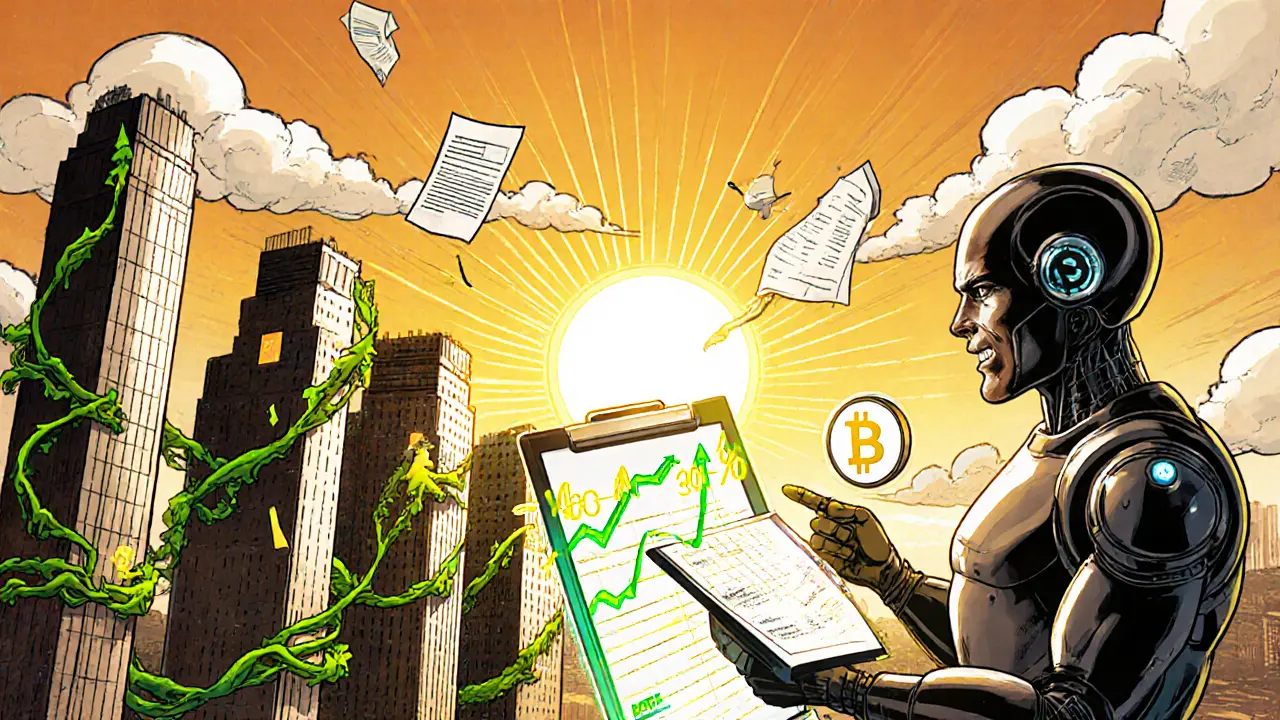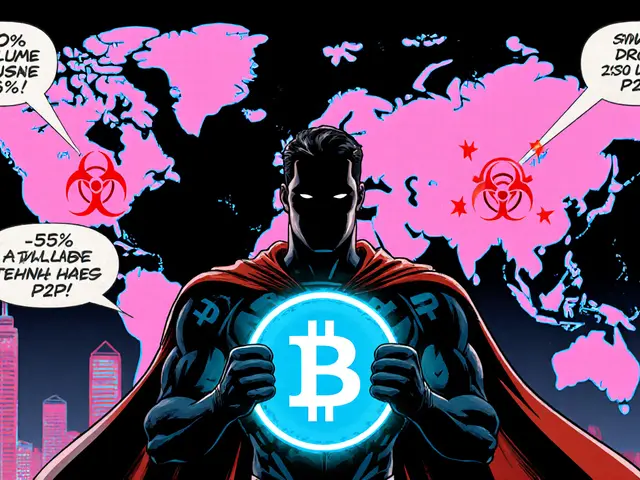P2P Crypto Trading Volume Estimator
Estimate P2P Trading Volume Impact
Adjust the parameters below to see how various factors affect P2P trading volumes in restricted countries.
Estimated Impact Analysis
Key Takeaways
- OFAC sanctions cut cross‑border P2P volume by roughly 60% in Russia and Iran during 2024‑2025.
- Only 12% of emerging markets still enforce outright crypto bans, but many maintain tight P2P limits.
- Major platforms such as OKX and Binance now block P2P services in 20+ high‑risk jurisdictions.
- Stablecoin freezes rose 35% YoY, removing $740million from the P2P pool.
- Future growth depends on regulatory liberalisation in emerging markets, not on technical constraints.
When governments clamp down on centralized exchanges, traders often turn to peer‑to‑peer (P2P) markets. That shift creates a hidden but measurable flow of digital assets, especially in countries where official crypto activity is limited or outright banned. Below we break down the forces shaping P2P crypto trading volumes in restricted jurisdictions, show where the biggest drops have happened, and outline what the next year could look like.
What “P2P Crypto Trading Volumes” Actually Mean
P2P crypto trading volumes are the total value of cryptocurrency exchanged directly between individuals on decentralized platforms, without a central order‑book operator. The metric tracks fiat‑to‑crypto, crypto‑to‑crypto, and stablecoin swaps that happen on marketplaces, messenger‑based groups, or on‑chain escrow contracts. Unlike exchange‑reported turnover, P2P volumes are pieced together from blockchain analytics, platform‑level disclosures, and on‑ground surveys.
Regulatory Landscape in 2025
Between 2023 and 2025 the global stance on crypto shifted dramatically. A 2025 regulatory analysis shows that only 12% of emerging markets maintain an outright ban on crypto trading, down from 19% in 2023. The remaining 88% permit crypto under specific frameworks-yet many of those frameworks include strict rules on P2P activity, especially where sanctions or banking prohibitions apply.
Key regulatory drivers include:
- International sanctions regimes (primarily OFAC in the United States).
- Domestic banking bans that prevent fiat‑to‑crypto conversions.
- Compliance requirements imposed on major exchanges that cascade down to P2P networks.
OFAC Sanctions: The Biggest Volume Killer
The Office of Foreign Assets Control (OFAC) expanded its sanctions list in late 2023, adding several Russian and Iranian crypto services. The impact was immediate:
- Cross‑border P2P volume on Russian platforms fell by 60% in the first six months of 2024.
- Iran experienced a similar 58% drop, as most local escrow services were forced offline.
- Global crypto transaction volume linked to sanctioned entities slid 18% between 2023 and 2024.
Beyond direct bans, OFAC froze $740million worth of stablecoins in 2024-a 35% increase over 2023-removing liquidity that would otherwise have fed P2P swaps.

How Major Exchanges Shape the P2P Landscape
Even though P2P trading can happen on fully decentralized protocols, most retail users rely on exchange‑run P2P desks for escrow, identity verification, and dispute resolution. The policies of the world’s biggest platforms therefore set de‑facto borders.
| Exchange | Number of Restricted Jurisdictions | Notable High‑Sanction Countries | Policy Type |
|---|---|---|---|
| OKX | 20+ | Afghanistan, Iran, North Korea, Syria, Cuba | Full P2P block in high‑sanction zones; limited service in selective markets |
| Binance | 10+ | Nigeria, Canada, Japan, India | d>Partial block (crypto‑to‑fiat) or complete withdrawal in high‑risk areas|
| LocalBitcoins | 15 | Russia, Iran, Venezuela | Suspended escrow for flagged wallets; increased KYC thresholds |
These restrictions reduce the pool of available counterparties, pushing users in censored nations toward informal channels-often with higher fees and lower security.
Country‑Specific P2P Rules
Below is a quick snapshot of how different jurisdictions treat P2P trading.
| Country | Regulatory Stance | Impact on Volume |
|---|---|---|
| Pakistan | Allowed under strict oversight | Moderate growth; platforms require local KYC |
| Argentina | Legal for international trade settlements | Sharp rise in cross‑border P2P volumes (≈+45% YoY) |
| Kenya | Ban lifted on crypto banking services (2024) | Emerging P2P market; volume up ~30% |
| Vietnam | Decriminalized; focus on consumer protection | Stable P2P activity, but no explosive growth |
| Turkey | Limited legalization; retail crypto bans remain | Fragmented P2P; users rely on offshore desks |
| China | Full ban on crypto, including P2P | Virtually zero legal P2P volume |
Countries that maintain a blanket ban (e.g., Egypt, Algeria, Bolivia) effectively erase any legal P2P activity. In contrast, nations that adopt a “regulated‑but‑restricted” model still see measurable volumes, albeit filtered through compliance layers.
Volume Trends: Numbers That Tell the Story
Aggregated blockchain analytics from 2023‑2025 reveal the following headline figures:
- Global P2P crypto trading volume in 2024 reached $13.2billion, a 7% dip from 2023.
- OFAC‑related restrictions accounted for $1.2billion of the 2024 decline, affecting 17 countries.
- Stablecoin‑based P2P swaps fell by 12% after the 2024 freeze of $740million.
- Emerging‑market P2P volumes grew 15% YoY, driven by Argentina, Kenya, and Philippines.
- In high‑sanction zones (Russia, Iran, North Korea) P2P activity fell by over 50% year‑over‑year.
These data points illustrate a split picture: while sanctions suppress volumes in some regions, a wave of regulatory acceptance elsewhere is generating fresh demand.
Why Technical Limits Aren’t the Bottleneck
Some readers wonder if blockchain capacity or network fees are choking P2P growth. The reality is that the technology can handle far more swaps than the market currently demands. Proof‑of‑work congestion spikes occasionally raise fees, but most P2P desks operate on Layer‑2 solutions (e.g., Lightning Network, zk‑Rollups) that keep costs low. The real friction comes from:
- Legal risk for counterparties.
- Access to fiat banking channels.
- Exchange‑level KYC/AML blocks that blacklist wallets.
Hence, any future surge will be tied to policy shifts rather than protocol upgrades.
Looking Ahead: 2026 and Beyond
Two trends are likely to dominate the next 12‑18 months:
- Selective liberalisation in emerging markets. Nations like Argentina and Kenya are already drafting “crypto‑friendly” statutes that explicitly recognise P2P desks.
- Intensified sanctions compliance by global exchanges. Expect more automated wallet‑screening tools, which could shrink the grey‑area for users in sanctioned countries.
If you are a trader living in a restricted jurisdiction, the practical steps are:
- Identify exchanges that still offer P2P escrow in your country (e.g., smaller regional platforms).
- Use privacy‑preserving wallets that are not on OFAC’s SDN list.
- Stay updated on local regulatory announcements; a single law change can flip volumes overnight.

Frequently Asked Questions
How are P2P crypto volumes measured?
Analysts combine on‑chain transaction data, escrow‑service logs, and self‑reported platform statistics. They filter out known mixers and bridge transfers to focus on genuine peer‑to‑peer swaps.
Why does OFAC have such a big impact on P2P trading?
OFAC can freeze assets, blacklist wallet addresses, and require U.S.-based exchanges to block users tied to sanctioned entities. Because many global platforms route through U.S. banking infrastructure, they must comply, which instantly cuts off P2P liquidity in the targeted countries.
Can I still trade P2P in a country with a full crypto ban?
Legally, no. In places like China or Egypt, the law prohibits any crypto activity, and local banks will block fiat‑to‑crypto conversions. Some users resort to offshore VPNs and informal messenger groups, but those methods carry high legal and security risks.
What’s the outlook for stablecoin usage in P2P trades?
Stablecoins remain the most efficient bridge between fiat and crypto in P2P markets. However, increased freezing actions by OFAC mean that traders are shifting toward decentralized stablecoins (e.g., DAI) that are less likely to be flagged.
Will decentralized finance (DeFi) platforms replace centralized P2P desks?
DeFi can provide escrow‑less swaps, but many users still prefer the buyer‑seller protection that centralized P2P desks offer. As compliance pressure rises, we may see a hybrid model where DeFi protocols handle settlement while a trusted third‑party verifies identity.


Brooklyn O'Neill
August 2, 2025 AT 10:12Thanks for pulling together all those numbers – it really helps paint a clearer picture of how sanctions are reshaping P2P flows. I especially appreciate the breakdown by country; it shows that emerging markets like Kenya and Argentina are still finding ways to grow despite the pressure. It would be great to see a follow‑up that dives deeper into the impact on everyday users, not just the macro stats.
Ciaran Byrne
August 2, 2025 AT 22:42Nice summary – the sanctions hit Russia and Iran the hardest.
Patrick MANCLIÈRE
August 3, 2025 AT 11:12When we look at the P2P landscape in 2025, the first thing that stands out is the sheer variability in regulatory responses across jurisdictions. In Russia, the OFAC sanctions have slashed volume by roughly sixty percent, which aligns with the data showing a massive drop in escrow‑based trades. Iran mirrors that trend with a similar fifty‑eight percent decline, reflecting how local exchanges quickly disabled P2P desks under pressure. Conversely, countries like Argentina and Kenya are bucking the trend, posting increases of forty‑five and thirty percent respectively, thanks to more permissive policies and a surge in demand for stablecoins. The underlying driver for these gains is the relatively lax enforcement of KYC requirements, which lowers friction for peer‑to‑peer matches. Meanwhile, the global freeze of stablecoins – a $740 million hit in 2024 – illustrates how a single regulatory action can ripple through multiple markets simultaneously. It’s also worth noting that despite the technical capacity of blockchains to handle far larger throughput, the real bottleneck remains legal risk and fiat gateway access. Platforms such as OKX and Binance have responded by tightening their P2P services, effectively reducing the pool of counterparties in high‑risk regions. This creates a feedback loop: reduced liquidity pushes traders toward informal channels, which in turn raises compliance scrutiny. The data also reveal that emerging markets collectively added about fifteen percent to global P2P volume, highlighting that policy liberalisation can offset some of the losses elsewhere. However, the overall global figure still dipped by seven percent in 2024, underscoring that sanctions remain a dominant force. Looking ahead, if countries like Argentina codify crypto‑friendly legislation, we could see a sustained uplift in regional P2P activity. On the flip side, any escalation in sanctions compliance tools – especially automated wallet screening – could wipe out another chunk of the market. In short, the next year will likely be defined by a tug‑of‑war between regulatory tightening in sanctioned zones and liberalisation in emerging economies.
Carthach Ó Maonaigh
August 3, 2025 AT 23:42Yo, this whole OFAC circus is a dumpster fire – they freeze stablecoins like they're scared of a bad haircut. The sanctions are just a fancy way for big‑bank cronies to keep the little guys out of the game. If you ask me, the data proves the point: anywhere you see a drop, it’s because the powers that be are pulling the rug. And don’t even get me started on those “compliance” desks that act like gatekeepers of the crypto underworld. It's a laughable farce.
Marie-Pier Horth
August 4, 2025 AT 12:12Ah, the inexorable march of authority, a symphony of control echoing through the corridors of digital finance. One cannot help but feel the weight of destiny pressing upon the dwindling P2P volumes, as if the very soul of crypto were being siphoned into the abyss of regulation. The numbers tell a tale of loss, but also of resilience – a bittersweet reminder that even under siege, the spirit of peer‑to‑peer exchange persists.
Gregg Woodhouse
August 5, 2025 AT 00:42these stats r kinda meh.
F Yong
August 5, 2025 AT 13:12Well, isn’t it just charming that every time a government gets nervous they slap a freeze on stablecoins and watch the P2P market shudder like an old man with a cold? The irony isn’t lost on anyone who’s ever tried to move a dollar across a border under watchful eyes.
Sara Jane Breault
August 6, 2025 AT 01:42Great job breaking this down its super helpful for anyone trying to understand the market keep it up
Rachel Kasdin
August 6, 2025 AT 14:12America's crypto future ain't gonna die because some foreign sanctions try to choke it we got the tech and the will to keep the market booming
karsten wall
August 7, 2025 AT 02:42The data-driven assessment underscores a paradigm shift wherein macro‑regulatory vectors exert a deterministic influence on decentralized liquidity pools. In essence, the confluence of OFAC directives and exchange‑level KYC protocols engenders a quantifiable contraction in transaction throughput, particularly within high‑risk geographies.
Adeoye Emmanuel
August 7, 2025 AT 15:12The narrative painted here is both sobering and inspiring – while sanctions carve out deep fissures in the P2P ecosystem, the tenacity of users in places like Kenya and Argentina sparkles like a beacon of hope. It reminds us that innovation often flourishes under pressure, and the human drive to exchange value knows no borders.
Michael Ross
August 8, 2025 AT 03:42The analysis seems solid, though I’d be interested in seeing more granularity on how informal messenger groups contribute to the overall volume.
Deepak Chauhan
August 8, 2025 AT 16:12Esteemed colleagues, the recent escalation in OFAC enforcement undeniably curtails P2P activity across sanctioned territories. Yet, one must also acknowledge the adaptive strategies emerging in compliant markets. 😊
Aman Wasade
August 9, 2025 AT 04:42Oh great, another regulator stepping in – because what the crypto world really needed was more red tape to keep things "safe".
Lana Idalia
August 9, 2025 AT 17:12Everyone’s missing the bigger picture: the real driver isn’t just sanctions, it’s the underlying demand for cryptographic privacy tools that bypass any regulation.
Henry Mitchell IV
August 10, 2025 AT 05:42Interesting stats, thanks for sharing! 😊
Kamva Ndamase
August 10, 2025 AT 18:12Listen up, the crypto community is fed up with bureaucratic bullsh*t that tries to choke our markets. If you keep strangling P2P, you’ll only push us into the shadows where real innovation lives.
bhavin thakkar
August 11, 2025 AT 06:42Allow me to elucidate: the systemic contraction observed in the P2P sector is a direct consequence of geopolitical power plays, not mere market whims. The confluence of sanction regimes, exchange policy tightening, and fiat‑to‑crypto bottlenecks creates a perfect storm that suppresses liquidity on a global scale.
Thiago Rafael
August 11, 2025 AT 19:12In conclusion, the presented metrics provide a comprehensive overview of the current constraints imposed by international sanctions and exchange compliance measures. It is imperative for stakeholders to formulate adaptive strategies that mitigate these regulatory pressures while fostering sustainable growth in the P2P domain.
Janelle Hansford
August 12, 2025 AT 07:42Love how the data shows opportunities popping up in places like Kenya – keep the positive vibes rolling and let’s support those emerging markets!
Marie Salcedo
August 12, 2025 AT 20:12Great info! Thanks for sharing.
dennis shiner
August 13, 2025 AT 08:42Yeah, because stopping people from trading is always a brilliant idea.
Krystine Kruchten
August 13, 2025 AT 21:12The analysis is spot on – great work on pulling these numbers together.
Mangal Chauhan
August 14, 2025 AT 09:42Dear colleagues, your thorough breakdown of P2P dynamics offers invaluable insight for policymakers and market participants alike. Thank you for the diligent effort. 🙏